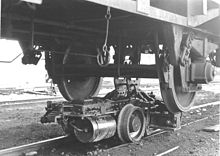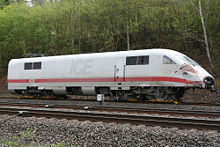Trestle
A trestle is a usually two-axle rail vehicle with which a different- track railway vehicle can be transported on the track width of the trestle. In southern Germany it is also known as a roller stool , but not in Switzerland , where this word describes a roller carriage .
history
The trestle was invented in 1881 by Paul Langbein (1842–1908).
Function and general
The use of trolleys means that there is no need to reload the goods into vehicles of the other gauge in freight transport . The costs of reloading, which made the operation of narrow-gauge railways so expensive that their cost advantages could be lost again in installation and operation, were eliminated. Jacking up cars was not common, as the travelers themselves could change vehicles relatively easily and the risk of tipping over when transporting people was not acceptable. On special occasions, however, special wagons were loaded, e.g. B. Salon or cinema car . Basically, it should be noted that, especially in Germany, there is or was no coherent narrow-gauge network similar to that in standard gauge. For this reason, extensive standardization and standardization to ensure interoperability for standard-gauge railways was not mandatory and did not take place. As a result, there were numerous technical isolated solutions, including the roller stands. The basic function is always the same. In addition to technical differences, the regulations for operation were also different, with the regulations partly influencing the technology, but partly also being issued as a result of the technical requirements.
Today, roller stands are also used by the railway industry to transport other- gauge vehicles on standard gauge from the manufacturer to test facilities or to their area of use. RailAdventure GmbH uses such vehicles - they call them Loco buggies .
technology
The Rollbock is a narrow-gauge vehicle with a very short wheelbase (similar to a bogie ), on which the wheels of each wheel set of the standard-gauge wagon are anchored. Two roll stands are always required for a two-axle freight wagon. The trolley is loaded from a special trolley pit . Depending on the specific design of the roll stands, z. T. three-axle wagons can also be jacked up, for example with the trolley railway , which had special trolleys for this purpose. There were no such special roll stands in Württemberg, which is why jacking up three-axle vehicles was prohibited.
Freight wagons on trestles (or trolleys ) can be put together to form entire freight trains . Depending on the local operating regulations, narrow-gauge passenger cars could also be lined up in the trains, and the sequence was often regulated. A common rule stated, for example, that unloaded roller stands were only allowed to walk at the end. Thus one wanted to avoid derailments of the light vehicles in the train composition. Some of the trolleys were or are equipped with the respective braking system ( compressed air , suction air ) or lever brake of the narrow-gauge railway, but there were also unbraked trolleys. In this case, some railways installed so-called brake cars in the trains, which were ballasted in order to have greater braking power. In some cases, the brake lines of the standard gauge wagons were also used and the roller brakes were connected to them via T-pieces. Standard gauge wagons on roller stands are either coupled directly to one another or the roller stands are connected by means of coupling rods . With the direct coupling, these are to be made “long”, that is, not to be tightened, as the buffers would otherwise push the trolleys in the often narrow radii off the trestles. The connection to the towing vehicle can also be made via coupling rods. But there is also the option of using so-called buffer trolleys . These narrow-gauge wagons have pulling and pushing devices that match those of the jacked-up standard-gauge wagons in terms of design and height and thus serve as an adapter. Locomotives with such adapted standard gauge pull-and-bumpers were also used.
Systems and Development
Trolleys as a forerunner
The trolley is the predecessor of the trolley. It was invented in 1880 by the Schweizer Maschinenfabrik Winterthur (SLM) to promote the sale of narrow-gauge vehicle material. Because the early narrow-gauge locomotives were small and inefficient, the high "dead" (useless) weight of the trolley was a hindrance. However, the handling of the trolleys was easier and less dangerous than the classic trolleys. Therefore the trolleys replaced the trolleys in some areas again. There was also the mixed use of trestles and trolleys, but this was rather rare because otherwise two different loading devices were required at the same time.
Long leg system

In order to reduce the heavy dead weight of trolleys, Paul Langbein, director of the Saronno / Italy branch of Maschinenfabrik Esslingen , invented the trolley in 1881, in which the heavy frame of the trolley was omitted. His invention was awarded a prize by the Association of German Railway Administrations.
After the trolley is pushed under the axle, the fork (s) is / are folded up. Fixed in this way, the standard-gauge wagon can be lowered onto the trestle when pushing away in the direction of the narrow-gauge track with the help of an inclined plane , alternatively via a small step in the standard-gauge track (see photo). The forks of the trestle are only used to drag the standard-gauge wagon while it is being jacked up and down in the pit, not - as is often mistakenly assumed - to fix the standard-gauge wagon during transport. On the route, the forks only have the function of additional safety. The wheel sets rest with the wheel flanges on the rotatably mounted crossbeams of the trolleys, which are shaped as troughs. The wheels of the full-gauge wagon are fixed there with spindles.
For reasons of patent law, other manufacturers have built roll stands in which the axle of the standard gauge wagon was actually seated in the - in this case far outside - forks, which, however, caused problems with the brake linkage or the diameter of the axles.
The handling of the long-legged trestles was very difficult: The trolleys had to be pushed in the pit under the wagons. The forks were raised on the axles. Especially when transporting large cattle, this work was often associated with considerable nuisance for the staff due to the leaking animal urine.
When maneuvering, the trolleys were often moved with coupling rods . These had a weight of over 50 kg and were therefore difficult to handle. Attempts to make the work easier by keeping the coupling rods on the locomotive even without the roller blocks connected and stretching out like a lance, led to dangerous situations and numerous, sometimes serious, accidents.
System Vevey

In 1974 the Swiss railway company YSteC developed a new principle in order to simplify the loading process, which is labor-intensive and time-consuming with the Langbein system . The axle of the standard gauge wagon is no longer fixed. The car stands with its wheels in specially shaped hollows. Rolling stands of this type - produced in series as the Vevey system by Ateliers de constructions mécaniques de Vevey (ACMV) - are used by several railways in Switzerland and one in Germany . The main difference to the classic roller stand is that jacking up happens automatically when driving slowly. Thus, numerous inconveniences and potential hazards are eliminated, which is why z. B. the Harz Narrow Gauge Railways has replaced their trolleys with such trolleys, similar to various Swiss railways before.
The possible rationalization could not prevent that the freight traffic on numerous narrow-gauge railways was nevertheless stopped. Rolling stands in commercial operation are only available in Nordhausen , Langenthal , Bulle , Morges and Yverdon , the system in Worblaufen is still used for service transport.
Other function
Rolling stands are similar to constructions in order to be able to move unfit vehicles in repair shops, after accidents or during assembly - even on the same track width. Depending on whether they completely replace the running gear or just support it, they are usually referred to as auxiliary bogies or axle breakers / diplories.
See also
In the list of narrow-gauge railways in Switzerland and the list of former Swiss railway lines , all existing and former Swiss railways with roll-bar traffic are listed.
literature
- Max Mayer: Esslingen locomotives, wagons and mountain railways - historical development in the Eßlingen machine factory since 1846 . VDI-Verlag GMBH Berlin SW 19, 1924. Page 201 ff.
- Communications about the entire local and tram system , Hanover, year 1881/82
- Victor von Röll : Enzyklopädie des Eisenbahnwesens , Volume 8, 1912 edition, p. 229 ff. Digitized
Web links
- Use of roller stands on the Harz Narrow Gauge Railways (HSB) ( Memento from November 7, 2007 in the Internet Archive ), (archive.org, accessed on September 22, 2015)





